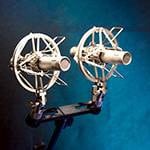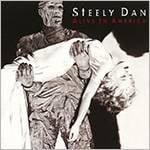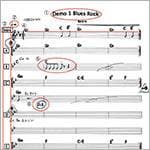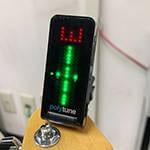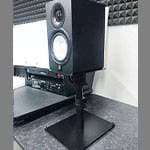In the previous article, we briefly revisited the history of trackers. Today, trackers are on the brink of extinction, yet they have shown remarkable resilience, surviving through long, harsh winters of disuse and obscurity. In this article, we’ll explore where modern tracker SunVox stands in the current DAW-dominated landscape—and what unique advantages it offers.
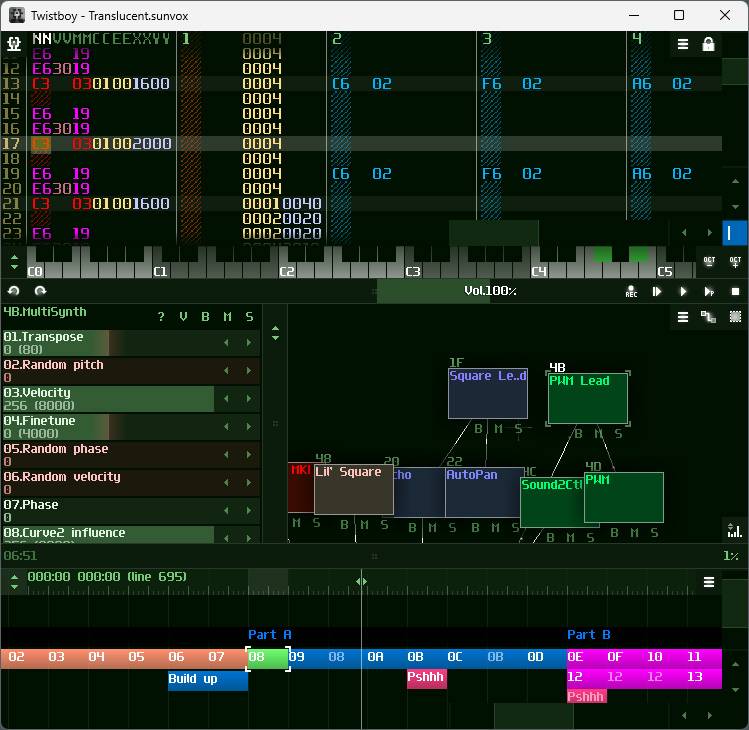
Modern Music Production Is DAW-Centric
Since both trackers and DAWs serve similar purposes in music production. The differences between them are naturally worth examining. In simple terms, a DAW (Digital Audio Workstation) is a virtual music production environment that brings most of the traditional studio workflow into a computer. In the past, recording required a tape recorder, mixing required a physical mixer, and effects or electronic instruments demanded dedicated hardware. But now, thanks to software-based solutions, all of this can be consolidated into a digital setup—minimizing the need for hardware, improving efficiency, and cutting costs.Since the 2000s, DAW technology has improved significantly, becoming indispensable for modern music creation. Affordable pricing and accessibility have lowered the entry barrier, making DAWs a go-to tool for hobbyists as well. The market has clearly grown.However, DAWs are still professional-grade tools, and using them effectively requires a broad base of knowledge and experience. Beginners with no background who dive into DAWs just because they're affordable will quickly realize that the learning curve is steep. You’ll need the same level of commitment as if you were building a full-fledged recording studio.
Trackers Prioritize the PC
Unlike DAWs, trackers were designed from the outset as music production environments that run entirely on a PC—with no need for external hardware. At their core, trackers work by arranging sampled sounds to create music. The process is more akin to using a sampler: assigning pitch to samples, looping them, and applying step-by-step manipulations. These are tasks that computers excel at, but they’re not centered around human-friendly workflows. Instead, humans must adapt to the machine. Traditional music production processes are largely irrelevant in the tracker paradigm. This fundamental difference in origin and intent sets trackers apart from DAWs—they come from opposite directions. This contrast also explains why trackers have generally not been embraced by traditional musicians. However, paradoxically, this exact rigidity and logic-based structure is what attracts a certain kind of user—those who are fascinated by the tracker experience. Let’s take a closer look at what makes SunVox, a modern tracker, so unique.
SunVox Feature #1: User Interface
One of SunVox’s most outstanding aspects is its screen layout. The interface is divided into four functional areas, and you can freely adjust their proportions to suit your workflow. This allows for efficient operation while maintaining a full overview of your project—there are no tabbed views or hidden windows to switch between. Remarkably, even on an old-school resolution like 640×480, as shown in the video below, the interface remains fully usable. This kind of flexibility and minimalism is rare in modern music software. Personally, this is the part of SunVox’s design that I hold in the highest regard.
SunVox Feature #2: Minimal, Self-Contained Tracker
This is the second most highly regarded feature for me personally. SunVox is a compact program with a minimal footprint—not just in file size, but also in its design philosophy. Unlike typical DAWs, which often rely heavily on third-party plugins and expansions, SunVox is relatively self-contained. While this may limit extensibility and seem restrictive compared to more open music software, it comes with a key advantage:
You can perfectly reproduce another user's project on your own setup, without worrying about missing plugins or compatibility issues.
In the small but passionate SunVox community, this makes sharing and collaboration far easier and more reliable. It’s a thoughtful design choice that supports the ecosystem well.
SunVox Feature 3: Synthesizers
Trackers are originally based on sample-oriented music production, but in SunVox, more emphasis is placed on built-in synthesizers than on samples. For that reason, it's possible to produce music without using any samples at all. For pure tracker users, this may seem unorthodox. Even so, since traditional trackers also controlled FM sound sources like OPL2, it’s considered to be within the acceptable range. Personally, I rarely use samplers due to the amount of time involved . If there’s a sound that absolutely cannot be expressed with built-in synthesizers, then I use samples. But when I want to do something more elaborate, I use a DAW instead.
SunVox's built-in synthesizers are conceptually close to modular synths. However, they are somewhat imprecise. For users who want precise hardware-like control, it may feel incomplete, and there may be doubts about the connection order. Even so, once you get used to the unique SunVox rules, there’s no major issue. Overall, it’s very efficient for quick and rough production. That said, over the course of several version updates, features have been added based on user requests, and as a result, the settings have become complicated and slightly chaotic.
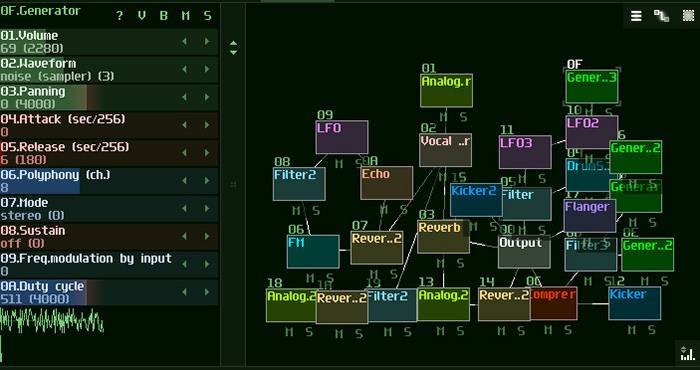
SunVox Feature 4: Timeline
Traditional trackers do almost everything within the pattern editor, but SunVox uses a method where each pattern is arranged on a timeline. This approach is similar to the track-based concept in DAWs. As a result, editing flexibility is improved, and overall visibility is better. It’s a very convenient feature when you want to change the structure later on, and it can be considered to be one of SunVox’s major features.
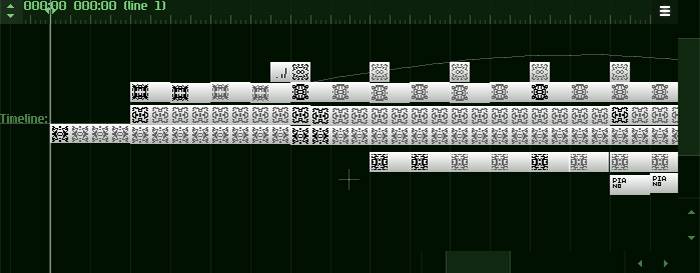
SunVox Feature 5: Pattern Editor
SunVox’s music production is basically traditional step-sequencing, with the pattern editor playing the central role. This corresponds to the piano roll in DAWs but offers far greater flexibility. Since the content is written as text strings, it represents the most programming-like aspect and is characteristic of trackers. Because many behaviors are recorded here, there is no need to check multiple places, which contributes to better clarity.
However, SunVox differs from traditional trackers in that clicking a pattern arranged on the timeline displays its content in the pattern editor. The advantage of this system is that the pattern information is kept to a minimum, making it easier to view.
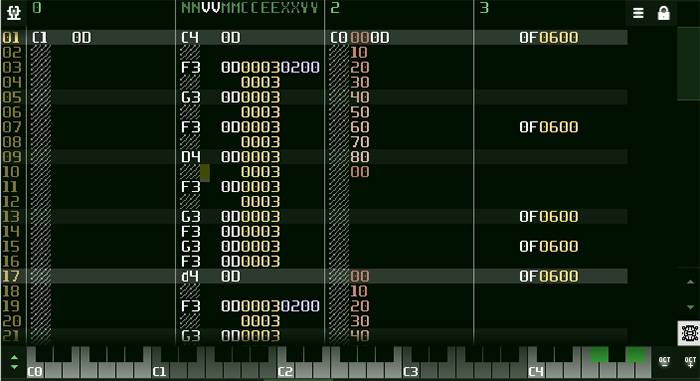
SunVox Feature 6: Fast Production Speed
Using SunVox, you can work faster than with heavy-duty DAWs. One reason for this is the ability to always maintain an overview during production. Alternatively, it can be said that SunVox has the flexibility to enable such a production method. In DAWs, you often need to access various places while editing, but in SunVox, you can edit different instruments and effects simultaneously, even when they are mixed together.
Another reason is that each process has fewer functions, so you won't dig too deep and tend to move on to the next process. While this may seem like a disadvantage at first glance, it allows you to focus more on the overall picture, resulting in a smoother workflow.
When using SunVox, you come to realize that being able to do everything is not necessarily always a good thing.
SunVox Feature 7: Relatively Easy to Learn
Since DAWs have specialized, professional-level functions, they inevitably take a lot of time to master. Each plugin is deep and endless to explore.
On the other hand, once you understand the basic concepts, SunVox is relatively easy to learn. Although it covers general music production comprehensively, its functions are relatively few and well-organized. Compared to DAWs, there is much less to memorize, so after a few hours of experimenting, you can use it to some extent.
SunVox Feature 8: Songs Themselves Serve as Teaching Material
SunVox comes with sample songs. Unlike simple demos, these help you understand how they were created and even reveal the entire production process. In a way, you get to see the composer’s “hand”, so to speak. If a composer’s composition is poor, that will also be obvious, so composers need courage to share their song data publicly. Many software tools require additional tutorials for learning, but in SunVox’s case, the sample songs themselves serve as educational material. Because it is easy to grasp the overall structure and doesn’t rely on external extensions, this feature makes good use of SunVox’s characteristics.
SunVox Feature 9: Strengths and Limitations
SunVox is fundamentally designed for step-sequencing music production. Therefore, it is not well suited for recording or composing with live instruments. It’s not impossible to do those things, but using a DAW would be more comfortable. Since the input method is primarily step input rather than real-time input, it’s not suitable for people who dislike that style of creation. Overall, SunVox is better suited for people with a programmer-like mindset.
SunVox’s Place in the Market and Its Distinction from DAWs
It’s unclear to what extent the developer of SunVox considered the entire music market when deciding its direction, but it seems to be positioned quite delicately. Most trackers currently under development tend to follow a fairly traditional style. Some trackers have incorporated modern features and evolved into DAW-like software, but those cases are rare. Basically, development seems to be progressing within the cultural sphere of trackers. Among them, SunVox stands out as somewhat unique—it's a compact, self-contained type of tracker.
If a DAW is like a large toolbox or workshop that incorporates professional tools from the outside, then SunVox is like a Swiss Army knife. It provides just the bare minimum functions necessary, so you can do simple functions, but you cannot aim to reach the same level as a DAW. Still, because of its ease of use, it’s designed to be something you always want to carry with you. It will never replace a DAW, so there’s a certain mysterious coexistence between the two. Personally, I’ve been using it for about ten years, but I treat it as something completely different from a DAW. It feels almost like a toy that produces sound and I use it occasionally. However, if you take it seriously enough, it has enough potential to produce respectable results.
Next time, I would like to talk about how to use SunVox.
The column "sound&person" is made possible by contributions from everyone.
For more details about submissions, click here.






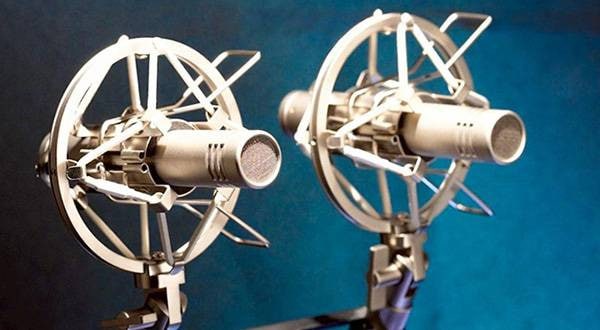
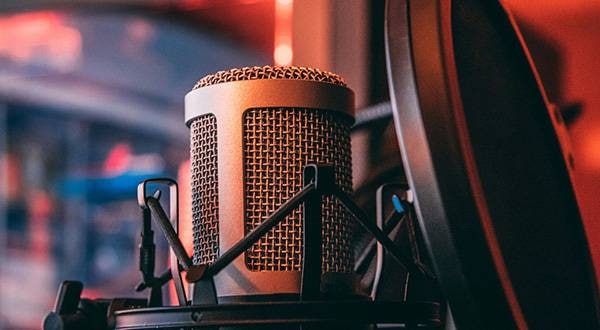
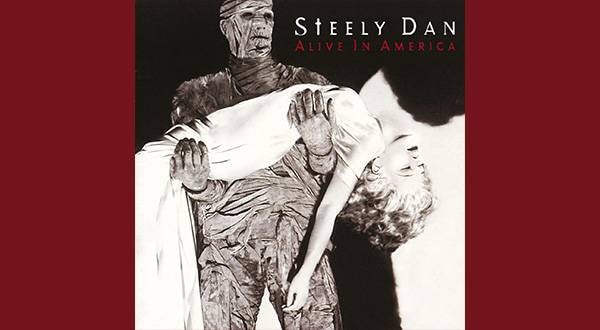
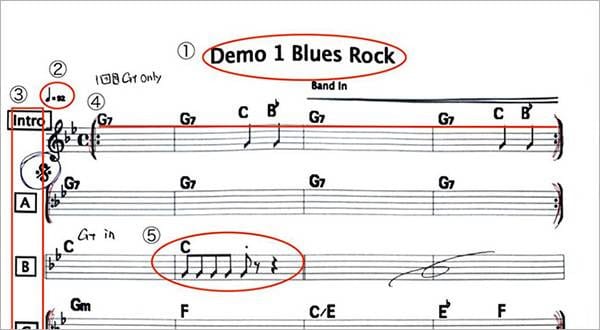
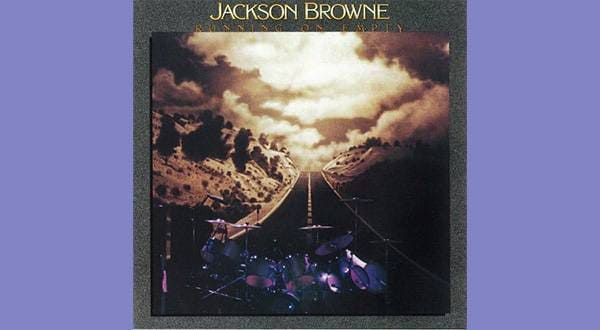
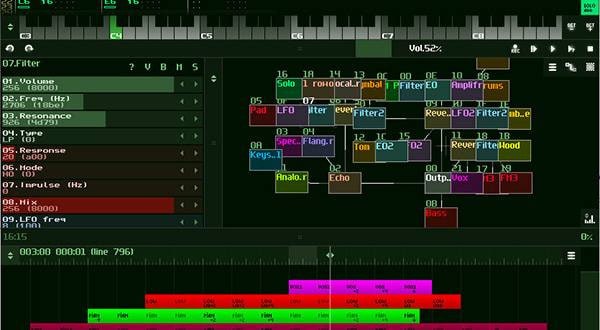
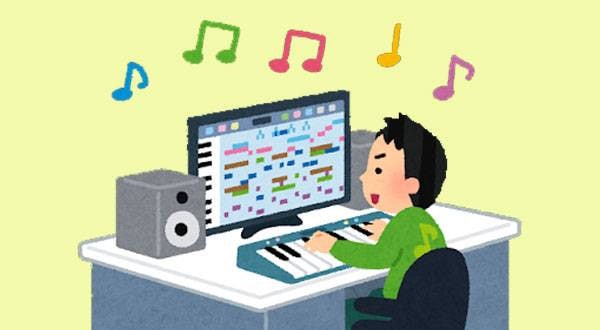
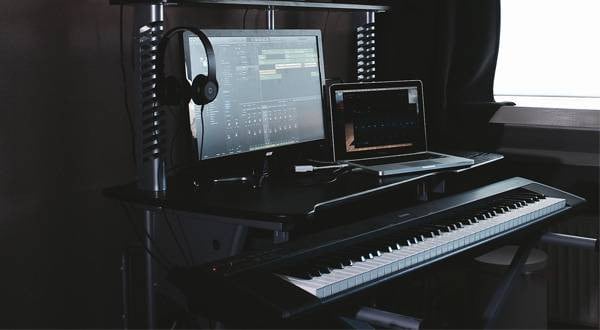
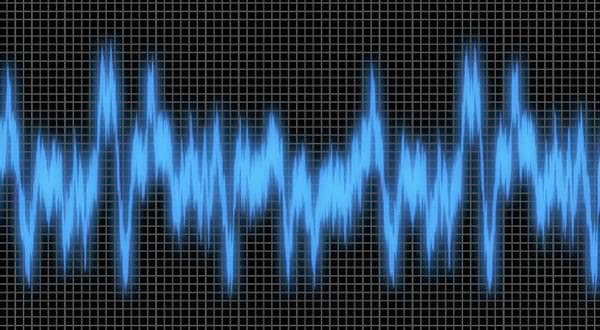
![[2023] Recommended Items for Music Programming - DAW/Software Instruments/Plug-ins](/contents/uploads/thumbs/2/2020/11/20201102_2_11495_1.jpg)
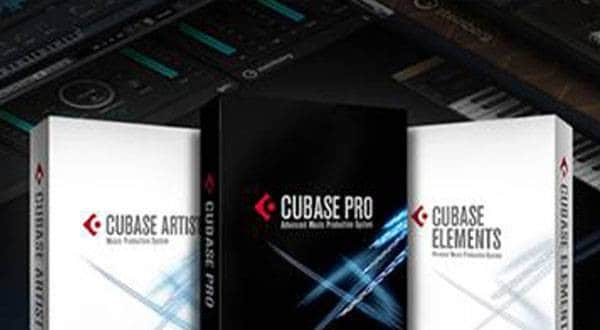
 厳選!人気のおすすめオーディオインターフェイス特集
厳選!人気のおすすめオーディオインターフェイス特集
 DTM対談 kors k × かめりあ × Hommarju
DTM対談 kors k × かめりあ × Hommarju
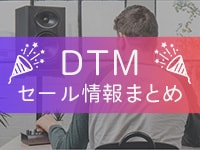 DTMセール情報まとめ
DTMセール情報まとめ
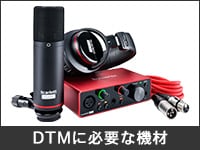 DTMに必要な機材
DTMに必要な機材
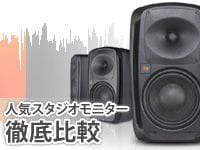 人気スタジオモニター徹底比較
人気スタジオモニター徹底比較
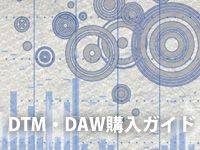 DTM・DAW購入ガイド
DTM・DAW購入ガイド
